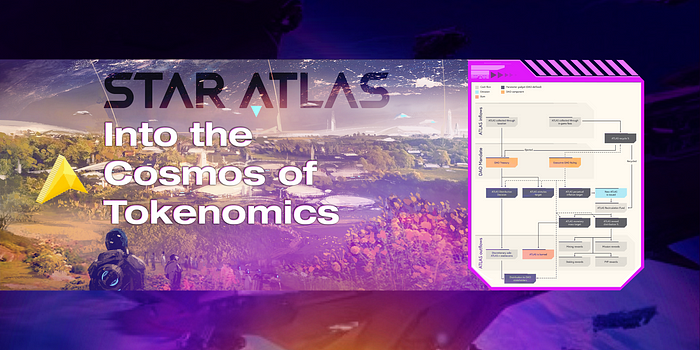Into The Cosmos Of Tokenomics — Star Atlas

The universe of Star Atlas is vast. A vast ecosystem requires a sustainable structure for it to witness unprecedented growth and to possess standards that lift the quality of life of its devoted citizens. Tokenomics play a crucial role in the journey towards achieving the above. It is through sound, complex, time-tested mechanics that one should build a structure for an economy that aims to bring prosperity upon its users. Countless months of brainstorming, strategizing and planning must be sacrificed to build up a robust structure for an in-game economy which is capable of enduring the forces of the open market and flow of value.
Star Atlas has utilized an economic system that allows participants to assume roles of many professions and endure on a path of being immersed in a race towards conquering the great unknowns of a vast universe.
Built with a skill tree progression which minimizes player fatigue, production, piloting, and overarching mechanics are the 3 large mechanisms that form up the economy as shown in the below graphic.
Rewards generated from piloting activities are the main inputs into the game economy, which flow into the markets that support piloting through the production game. Production connects mining, refining, and technological development to create new assets usable for piloting. Broader mechanics that underpin the game are land development, character development, and the DAO system.
As shown below, the in-game activities that players can enchant themselves by are divided into 5 main categories and users will be able to specialize in sub-activities inside these categories according to their preference.
- Resource Management — Mining will be an important pillar of the production aspect within the Star Atlas economy.
Examples of roles — Extractor, Refiner
- Building — Building is the exercise of finding the most efficient and novel ways to use farmed resources to create technological goods that can be utilized within the game.
Examples of roles — Research & development, Production
- Exploring — Exploration is one of the most complex and aspirational activities in the game. Explorers utilize ships and competitive technology to increase the efficiency and safety of discovering new planets and rare resources.
Examples of roles — Executive roles, Utility roles
- Fighting — Fighting is required to capture loot which can come in the form of resources and technological goods from other players to expand the boundaries of control of your faction.
Examples of roles — Executive roles, Combat roles
- Overarching activities — These are secondary roles that make the overall gameplay more engaging and exciting.
Examples of roles — Retail Deck Manufacturers/Sellers, Social developers
In the heart of it all lies 4 pillars that allow the smooth functioning of all activities and value creation within the economy. They are as follows.
Star Atlas utilizes a two-token monetary structure to fuel its economy. $POLIS acts as the governance token that facilitates governance within all levels of the game. It represents financial stake and allows voting power in the DAOs where it is staked, and control of the Treasury. $ATLAS, on the other hand, provides value to the economy by being the reward token used as a medium of exchange. It has inflationary mechanics to support the growth of the in-game economy and acts as a monetary base for in-game interactions.
POLIS
$POLIS has a fixed supply and is aimed at being a long-term store of value that resembles the growth of Star Atlas.
$POLIS can be acquired in the following ways;
- Primary Issuance — The Star Atlas team may directly sell $POLIS tokens to potential governors
- Secondary Markets — Can be bought and sold on secondary markets, but come with a finite variety of lockup/vesting schedules
- In-game Rewards — Completing certain missions in-game
- Metagame Rewards:
a. Actively attracting new users that stay for some amount of time or generate some amount of value
b. Organize existing users into guilds/factions and more, based on what these guilds/factions produce
c. Guilds/Alliances will be rewarded with an amount of $POLIS based on how long they have actively participated in the universe. The reward structure will be calibrated to disincentivize churn.
- Governance Participation: Staking in the DAO and being active
- Meta-economics Rewards: Liquidity provision on AMMs and other DeFi entities
ATLAS
$ATLAS will be issued for completing in-game activities. It is required to purchase digital assets such as ships, crew, components, land, and equipment. Players seeking the monetary rewards available in-game will need to carefully balance their operating expenses against the income derived. Operating expenses, such as personnel for mining equipment, fuel for ships, and repairs for damages will all need to be paid in $ATLAS. It will also serve as the predominant currency within the in-house NFT marketplace.
The team has stated that the minting and burning of $ATLAS will be solely based on the game’s user base growth and adoption. $ATLAS supply and price will be kept at a reasonable level to maintain acceptable in-game NFT pricing internally and optimize the entry level for new users while allowing for external appreciation.
You will find the life cycle of $ATLAS below. ( The $ATLAS life cycle is defined by natural cash flows — in-game fees and taxation as inflows, rewards for in-game activities as outflows — that are coordinated by several parametric automatons and DAO decisions.)
The central loop connects in-game fees (such as ship fuel costs) and in-game rewards (such as mission payouts). There is a fixed percentage of currency recycling that goes directly into the ATLAS Recirculation Fund from fees and the rest goes into the DAO Treasury.
In-Game NFTs
All in-game items within Star Atlas are NFTs (Ships, equipment, components, crew, etc.). Items can be either dropped (i.e. acquired via completing quests/ exploration missions/P2P or P2E duels/digging on each planet’s archaeological sites) or crafted (by combining necessary resources). Any Star Atlas item can also be improved to increase its rarity.
Land
Land also plays an important part in the Star Atlas ecosystem. Each planet is divided into parcels. Specifics of each parcel (i.e. size, borders, location, current ownership) are recorded as on-chain NFT. All buildings are naturally built on land, with higher-end facilities requiring more developed land to function. To discourage flipping — in which a user purchases and simply holds land to profit from its value appreciation rather than its use — the game imposes Land Value Tax (LVT) on each land parcel according to its level.
As you may have noticed, the economy upon which Star Atlas is built utilizes a complex structure to maintain sustainability. This is just a piece of the pie that users who are interested in Star Atlas need to understand. The economy is built on layers upon layers to make gameplay strategic and to give the ecosystem a twist of real life. Star Atlas is packed with a multi-year development cycle that wishes to deliver the perfect space exploration title with a comprehensive sustainable economy built within it.
Star Atlas is one of the largest games currently under development in the GameFi space with a strong community to support its every action.
If you seek to know in-depth, how the entire economy of this vast universe is planned to be executed, we suggest you take a look at the following reports.
General Whitepaper — https://staratlas.com/assets/pdfs/white-paper.pdf
Economic paper — https://staratlas.com/assets/pdfs/economics-paper.pdf
Economics report for Q2 — https://staratlas.com/newsroom/economic-reports





Reviews